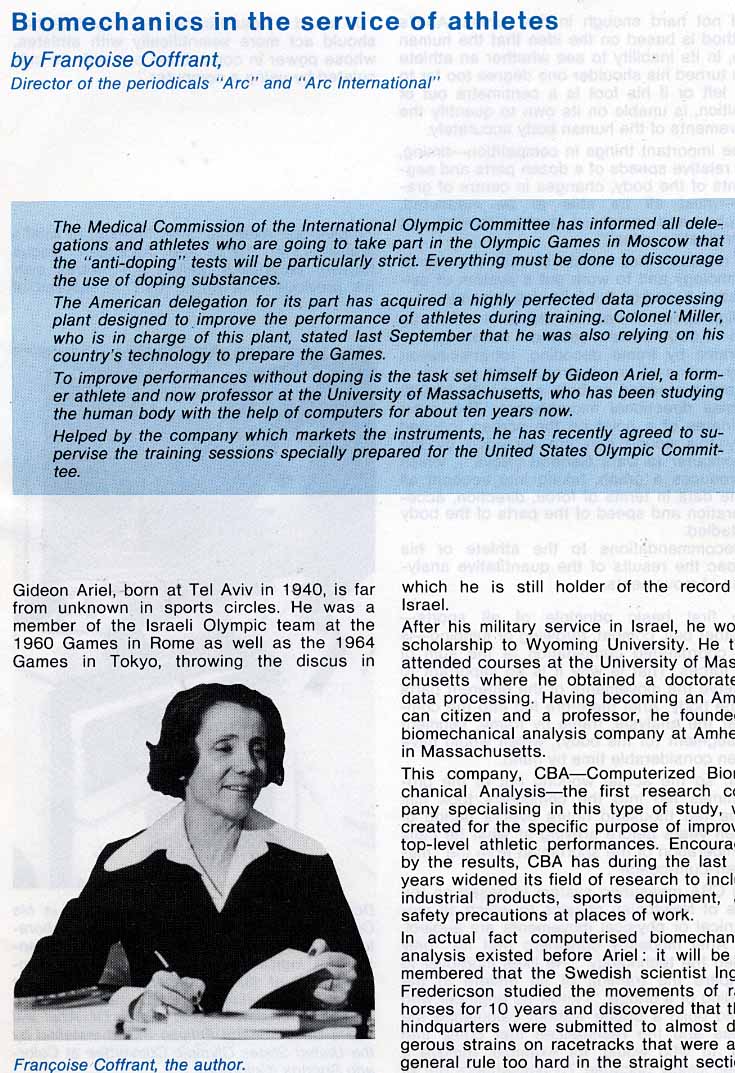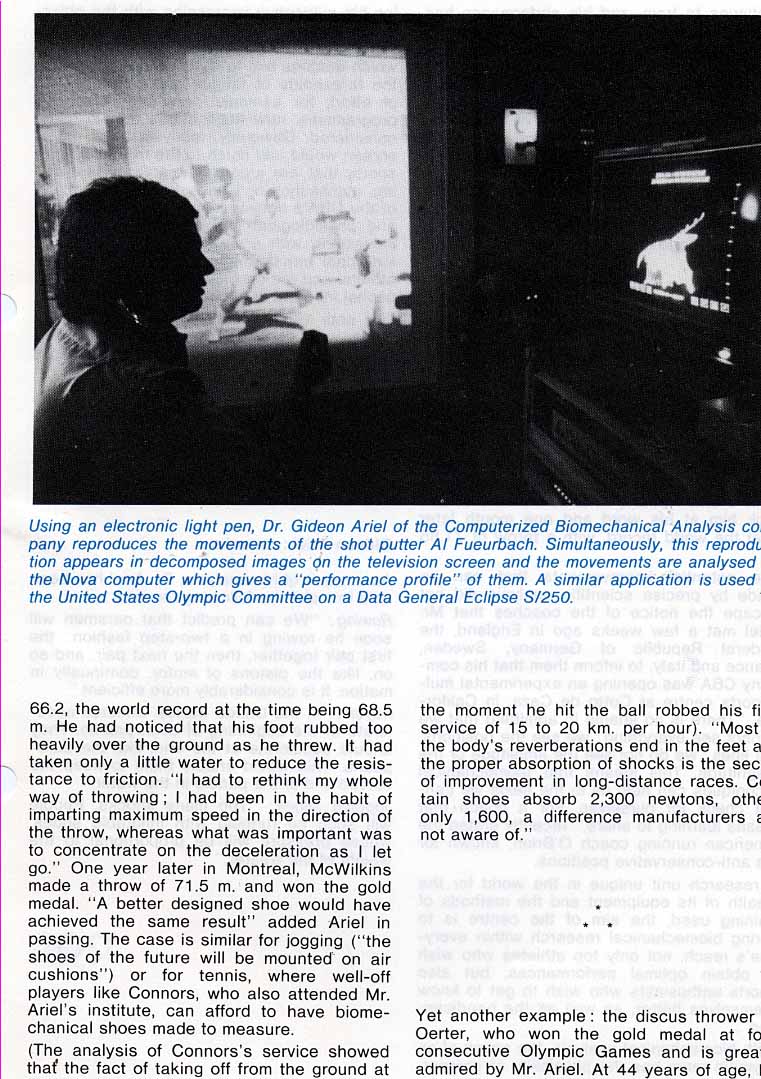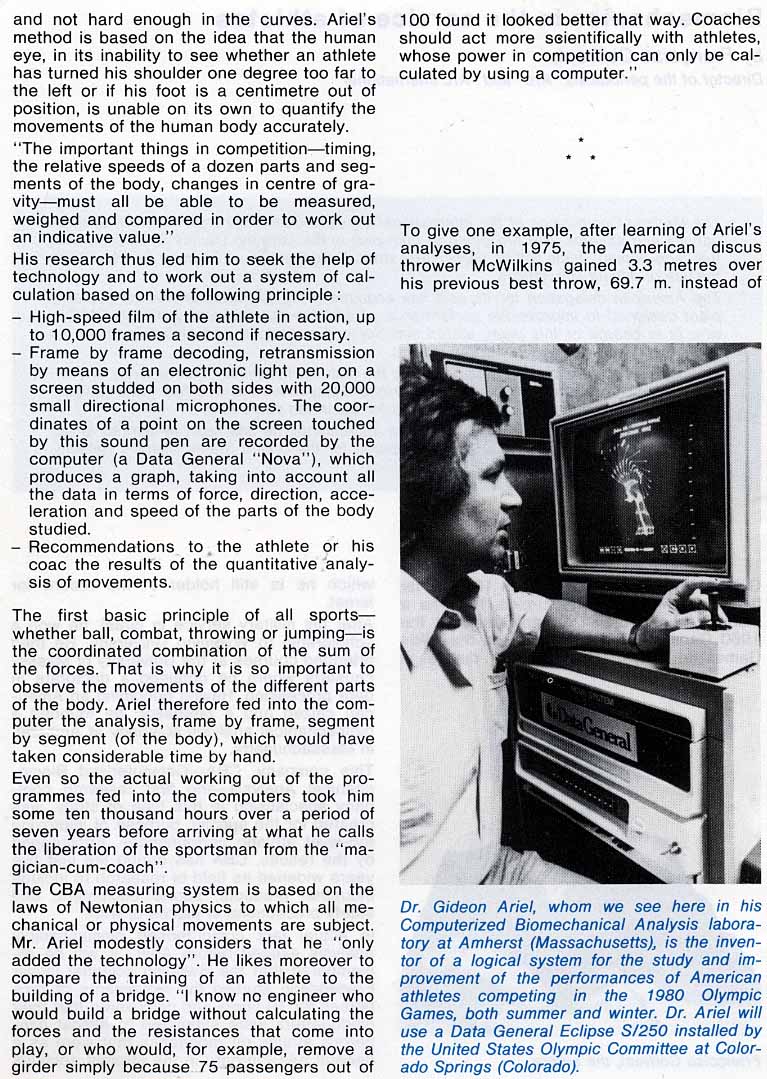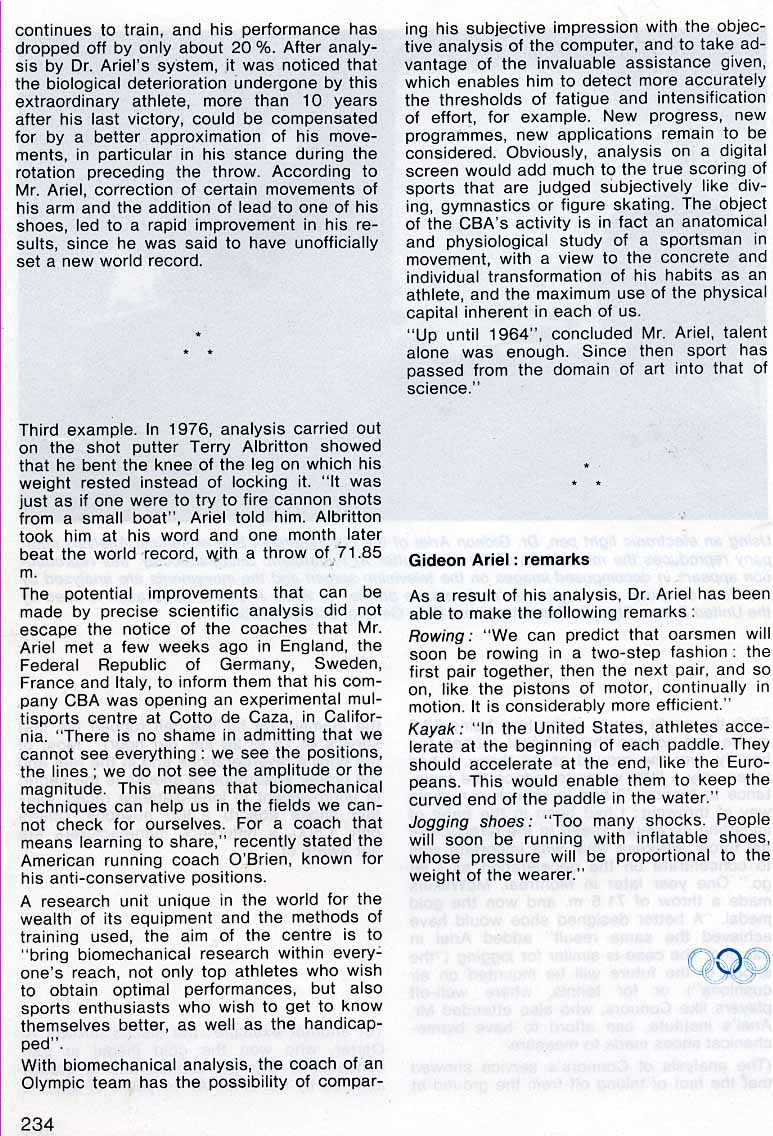Biomechanics in the service of athletes
The American delegation has acquired a highly perfected data processing plant designed to improve the performance of athletes during training.
By Françoise Coffrant in Olympic Review on Thursday, May 1, 1980
The Medical Commission of the International Olympic Committee has announced that anti-doping tests for the upcoming Moscow Olympic Games will be particularly strict. In response, the American delegation has invested in a sophisticated data processing plant to enhance athletes' performance during training. The plant is overseen by Colonel Miller, who is relying on American technology to prepare for the Games. Gideon Ariel, a former athlete and current professor at the University of Massachusetts, has been using computers to study the human body for the past decade. Ariel, who also runs a biomechanical analysis company, has agreed to supervise training sessions for the United States Olympic Committee. His company, CBA-Computerized Biomechanical Analysis, was created to improve top-level athletic performances and has expanded its research to include industrial products, sports equipment, and workplace safety precautions. Ariel's method involves high-speed filming of athletes in action, frame by frame decoding, and computer analysis to provide recommendations for performance improvement.
Tip: use the left and right arrow keys
Biomechanics in the service of athletes
by Francoise Coffrant,
Director of the periodicals "Arc" and "Arc International"
The Medical Commission of the International Olympic Committee has informed all delegations and athletes who are going to take part in the Olympic Games in Moscow that the "anti-doping" tests will be particularly strict. Everything must be done to discourage the use of doping substances.
The American delegation for its part has acquired a highly perfected data processing plant designed to improve the performance of athletes during training. Colonel Miller, who is in charge of this plant, stated last September that he was also relying on his country's technology to prepare the Games.
To improve performances without doping is the task set himself by Gideon Ariel, a former athlete and now professor at the University of Massachusetts, who has been studying the human body with the help of computers for about ten years now.
Helped by the company which markets the instruments, he has recently agreed to supervise the training sessions specially prepared for the United States Olympic Committee.
Gideon Ariel, born at Tel Aviv in 1940, is far from unknown in sports circles. He was a member of the Israeli Olympic team at the 1960 Games in Rome as well as the 1964 Games in Tokyo, throwing the discus in
s
Francoise Coffrant, the author.
which he is still holder of the record Israel.
After his military service in Israel, he wo scholarship to Wyoming University. He t attended courses at the University of Massachusetts where he obtained a doctorate data processing. Having becoming an Am can citizen and a professor, he founde biomechanical analysis company at Amhe in Massachusetts.
This company, CBA-Computerized Bioi chanical Analysis-the first research cs pany specialising in this type of study, created for the specific purpose of improN top-level athletic performances. Encoura by the results, CBA has during the last years widened its field of research to incl industrial products, sports equipment, safety precautions at places of work.
In actual fact computerised biomechan analysis existed before Ariel: it will be membered that the Swedish scientist Inc_ Fredericson studied the movements of r. horses for 10 years and discovered that tl hindquarters were submitted to almost d gerous strains on racetracks that were a general rule too hard in the straight secti
Using an electronic light pen, Dr. Gideon Ariel of the Computerized Biomechanical Analysis co pany reproduces the movements of the shot putter Al Fueurbach. Simultaneously, this reprodL tion appears in decomposed images on the television screen and the movements are analysed the Nova computer which gives a "performance profile" of them. A similar application is used the United States Olympic Committee on a Data General Eclipse S/250.
66.2, the world record at the time being 68.5 m. He had noticed that his foot rubbed too heavily over the ground as he threw. It had taken only a little water to reduce the resistance to friction. "I had to rethink my whole way of throwing ; I had been in the habit of imparting maximum speed in the direction of the throw, whereas what was important was to concentrate on the deceleration as I let go." One year later in Montreal, McWilkins made a throw of 71.5 m. and won the gold medal. "A better designed shoe would have achieved the same result" added Ariel in passing. The case is similar for jogging ("the shoes of the future will be mounted on air cushions") or for tennis, where well-off players like Connors, who also attended Mr. Ariel's institute, can afford to have biomechanical shoes made to measure.
(The analysis of Connors's service showed thaf the fact of taking off from the ground at
the moment he hit the ball robbed his fi service of 15 to 20 km. per hour). "Most the body's reverberations end in the feet a the proper absorption of shocks is the sec of improvement in long-distance races. C tain shoes absorb 2,300 newtons, othE only 1,600, a difference manufacturers E not aware of."
Yet another example: the discus thrower Oerter, who won the gold medal at fo consecutive Olympic Games and is grea admired by Mr. Ariel. At 44 years of age, I
and not hard enough in the curves. Ariel's method is based on the idea that the human eye, in its inability to see whether an athlete has turned his shoulder one degree too far to the left or if his foot is a centimetre out of position, is unable on its own to quantify the movements of the human body accurately.
"The important things in competition-timing, the relative speeds of a dozen parts and segments of the body, changes in centre of gravity-must all be able to be measured, weighed and compared in order to work out an indicative value."
His research thus led him to seek the help of technology and to work out a system of calculation based on the following principle High-speed film of the athlete in action, up to 10,000 frames a second if necessary. Frame by frame decoding, retransmission by means of an electronic light pen, on a screen studded on both sides with 20,000 small directional microphones. The coordinates of a point on the screen touched by this sound pen are recorded by the computer (a Data General "Nova"), which produces a graph, taking into account all the data in terms of force, direction, acceleration and speed of the parts of the body studied.
Recommendations to the athlete or his coac the results of the quantitative analysis of movements.
The first basic principle of all sportswhether ball, combat, throwing or jumping-is the coordinated combination of the sum of the forces. That is why it is so important to observe the movements of the different parts of the body. Ariel therefore fed into the computer the analysis, frame by frame, segment by segment (of the body), which would have taken considerable time by hand.
Even so the actual working out of the programmes fed into the computers took him some ten thousand hours over a period of seven years before arriving at what he calls the liberation of the sportsman from the "magician-cum-coach".
The CBA measuring system is based on the laws of Newtonian physics to which all mechanical or physical movements are subject. Mr. Ariel modestly considers that he "only added the technology". He likes moreover to compare the training of an athlete to the building of a bridge. "I know no engineer who would build a bridge without calculating the forces and the resistances that come into play, or who would, for example, remove a girder simply because 75 passengers out of 100 found it looked better that way. Coaches should act more scientifically with athletes, whose power in competition can only be calculated by using a computer."
To give one example, after learning of Ariel's analyses, in 1975, the American discus thrower McWilkins gained 3.3 metres over his previous best throw, 69.7 m. instead of Dr. Gideon Ariel, whom we see here in his Computerized Biomechanical Analysis laboratory at Amherst (Massachusetts), is the inventor of a logical system for the study and improvement of the performances of American athletes competing in the 1980 Olympic Games, both summer and winter. Dr. Ariel will use a Data General Eclipse S/250 installed by the United States Olympic Committee at Colorado Springs (Colorado).
continues to train, and his performance has dropped off by only about 20 %. After analysis by Dr. Ariel's system, it was noticed that the biological deterioration undergone by this extraordinary athlete, more than 10 years after his last victory, could be compensated for by a better approximation of his movements. in particular in his stance during the rotation preceding the throw. According to Mr. Ariel, correction of certain movements of his arm and the addition of lead to one of his shoes, led to a rapid improvement in his results, since he was said to have unofficially set a new world record.
Third example. In 1976, analysis carried out on the shot putter Terry Albritton showed that he bent the knee of the leg on which his weight rested instead of locking it. "It was just as if one were to try to fire cannon shots from a small boat", Ariel told him. Albritton took him at his word and one month later beat the world record, with a throw of 71.85 m.
The potential improvements that can be made by precise scientific analysis did not escape the notice of the coaches that Mr. Ariel met a few weeks ago in England, the Federal Republic of Germany, Sweden, France and Italy, to inform them that his company CBA was opening an experimental multisports centre at Cotto de Caza, in California. "There is no shame in admitting that we cannot see everything : we see the positions, the lines; we do not see the amplitude or the magnitude. This means that biomechanical techniques can help us in the fields we cannot check for ourselves. For a coach that means learning to share," recently stated the American running coach O'Brien, known for his anti-conservative positions.
A research unit unique in the world for the wealth of its equipment and the methods of training used, the aim of the centre is to "bring biomechanical research within everyone's reach, not only top athletes who wish to obtain optimal performances, but also sports enthusiasts who wish to get to know themselves better, as well as the handicapped".
With biomechanical analysis, the coach of an Olympic team has the possibility of comparing his subjective impression with the objective analysis of the computer, and to take advantage of the invaluable assistance given, which enables him to detect more accurately the thresholds of fatigue and intensification of effort, for example. New progress, new programmes, new applications remain to be considered. Obviously, analysis on a digital screen would add much to the true scoring of sports that are judged subjectively like diving, gymnastics or figure skating. The object of the CBA's activity is in fact an anatomical and physiological study of a sportsman in movement, with a view to the concrete and individual transformation of his habits as an athlete, and the maximum use of the physical capital inherent in each of us.
"Up until 1964", concluded Mr. Ariel, talent alone was enough. Since then sport has passed from the domain of art into that of science."
Gideon Ariel : remarks
As a result of his analysis, Dr. Ariel has been able to make the following remarks
Rowing: "We can predict that oarsmen will soon be rowing in a two-step fashion : the first pair together, then the next pair, and so on, like the pistons of motor, continually in motion. It is considerably more efficient."
Kayak : "In the United States, athletes accelerate at the beginning of each paddle. They should accelerate at the end, like the Europeans. This would enable them to keep the curved end of the paddle in the water."
Jogging shoes: "Too many shocks. People will soon be running with inflatable shoes, whose pressure will be proportional to the weight of the wearer."
234





